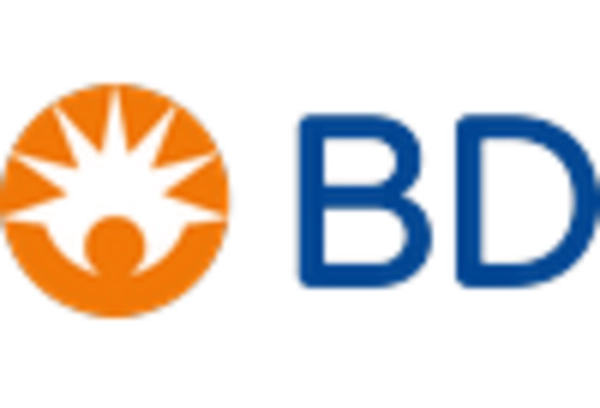Growing Biopharmaceutical Sector
The expansion of the biopharmaceutical sector in Japan is a significant driver for high throughput screening. With an increasing number of biopharmaceutical companies emerging, there is a heightened demand for efficient screening processes to expedite drug development. The biopharmaceutical market in Japan is expected to grow to $25 billion by 2027, with high throughput screening technologies being integral to this growth. These companies are leveraging high throughput screening to identify viable drug candidates more rapidly, thereby reducing time-to-market. This trend not only enhances the competitive edge of biopharmaceutical firms but also underscores the critical role of the high throughput-screening market in the overall healthcare landscape.
Rising Demand for Drug Discovery
The high throughput-screening market is significantly influenced by the rising demand for drug discovery in Japan. With an aging population and increasing prevalence of chronic diseases, there is a pressing need for new therapeutic solutions. Pharmaceutical companies are focusing on accelerating the drug development process to meet this demand, leading to a greater reliance on high throughput screening methodologies. In 2025, the market for drug discovery in Japan is expected to reach approximately $15 billion, with high throughput screening playing a crucial role in this growth. This demand is further fueled by collaborations between academic institutions and industry players, enhancing the capabilities of the high throughput-screening market.
Increased Focus on Personalized Medicine
The high throughput screening market is being propelled by an increased focus on personalized medicine in Japan. As healthcare shifts towards more individualized treatment approaches, the need for efficient screening methods that can identify patient-specific responses to drugs is becoming paramount. High throughput screening technologies enable researchers to analyze genetic variations and drug interactions at an unprecedented scale, facilitating the development of tailored therapies. The market for personalized medicine in Japan is projected to reach $8 billion by 2026, with high throughput screening being a critical component in this transformation. This trend indicates a shift in how treatments are developed and highlights the importance of the high throughput-screening market.
Government Support and Funding Initiatives
Government support and funding initiatives are pivotal drivers of the high throughput-screening market in Japan. The Japanese government has recognized the importance of biotechnology and pharmaceuticals in economic growth and is actively investing in research and development. Initiatives such as the Japan Agency for Medical Research and Development (AMED) provide substantial funding to projects that utilize high throughput screening technologies. In 2025, it is estimated that government funding for biotechnology research will exceed $2 billion, fostering innovation and development in the high throughput-screening market. This support not only enhances the capabilities of local companies but also attracts foreign investments, further stimulating market growth.
Technological Advancements in Screening Technologies
The high throughput screening market in Japan is experiencing a surge due to rapid technological advancements. Innovations in screening technologies, such as miniaturization and automation, are enhancing the efficiency and accuracy of drug discovery processes. For instance, the integration of artificial intelligence and machine learning algorithms is streamlining data analysis, allowing researchers to process vast amounts of data more effectively. This trend is reflected in the increasing investment in R&D, with the Japanese pharmaceutical sector allocating approximately $10 billion annually to enhance screening capabilities. As a result, the high throughput-screening market is projected to grow at a CAGR of 8% over the next five years, driven by these technological improvements.

















Leave a Comment